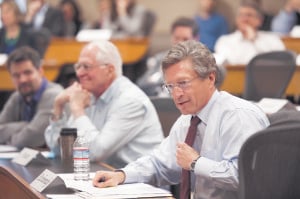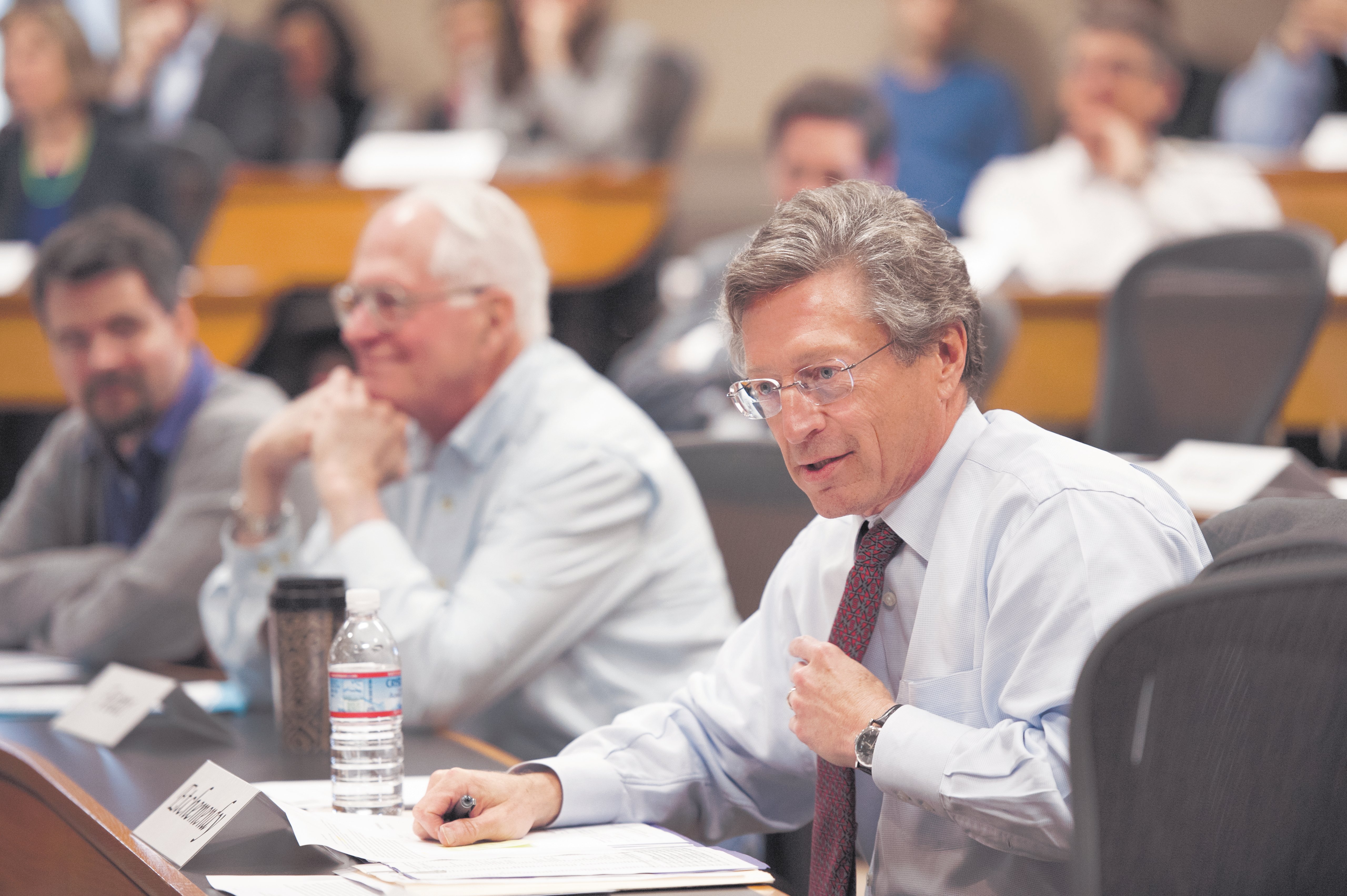The Faculty Senate heard a report on online education for the second time in the past six months at its Thursday afternoon meeting in an effort to further explore faculty concerns with and goals for the rapidly developing field.

Senate Chair Raymond Levitt, professor of civil and environmental engineering, opened the meeting by applauding the recent election of four School of Medicine faculty to the Institute of Medicine, as well as the selection of Alvin Roth M.A. ’73 Ph.D. ’74 as the 2012 winner of the Nobel Memorial Prize in Economic Science.
Provost John Etchemendy Ph.D. ’82 echoed Levitt’s congratulatory tone in announcing the selection of Chi-Chang Kao as the SLAC National Accelerator Laboratory’s fifth director. Kao, who is currently an associate laboratory director at SLAC, will assume his new position on Nov. 1.
“He’s a spectacular scientist and an extremely talented administrator,” Etchemendy said. “We did an absolutely thorough international search, and we found the right person right here in our backyard.”
Newly appointed Vice Provost for Online Learning (VPOL) John Mitchell framed his report on the state of online education at Stanford as a natural follow-up to the Senate’s discussion in April on the same subject. He insisted that the University should continue to prioritize on-campus students even as online education grows in popularity.
“Our primary educational mission is to teach students admitted to our programs,” Mitchell said.
He added, though, that technology used in online education could compliment offerings for on-campus students, potentially creating an overlap between the two options.
“We can develop material that is multi-purpose and use it [in] various ways,” Mitchell said. “We should take this as an opportunity to invest… and take advantage of opportunities.”
While Mitchell said existing University regulations should generally suffice in guiding course ownership and faculty regulations, he drew attention to concerns about faculty conflicts of interest—which he equated to working at another physical university—and online sites that aggregate Stanford content without giving due credit to the University.
“[Stanford] should get some recognition,” Mitchell said. “It would be better to have things packaged in a way that gives our University some acknowledgement.”
Reviewing VPOL’s work since the end of the last academic year, Mitchell noted the availability of seed grants for faculty innovation in online and blended courses. He also said efforts to reach out to departments have been highly fruitful, citing as an example the School of Medicine’s exploration of the “flipped classroom” concept.
“We’d like to leverage faculty creativity and initiative, and help [them] do something exciting in their teaching activities,” Mitchell said.
Bernd Girod, senior associate dean for online learning at the School of Engineering, was quick to discern between Stanford courses with an online component and online courses offered without Stanford credentials, such as massive open online courses (MOOCs). He said that while MOOCs should have the lowest priority, these courses do have significant value.
“These MOOCs can be a wonderful showcase for us, for Stanford engineering and Stanford education,” Girod said.
Charles Prober, senior associate dean for medical education at the School of Medicine, agreed that effectively combining online and physical resources, citing the “flipped classroom” model as a tried method of creating more interactive and effective learning sessions between students and faculty.
Discussion of the report focused largely on the impact of online education options on higher education, along with the risk that the inexpensive nature of online offerings could outcompete lower-profile physical counterparts, if not Stanford itself.
“It could well be that an online degree could be as valuable or even more valuable than the education you would receive in a struggling regional university,” Girod said.
Prober offered a more restrained outlook on the potential for significant disruption, arguing that an equilibrium point in the middle, where online and in-person education are effectively combined, is ultimately more likely.
“For many students, they may get the content [online],” Prober said. “When they see you, they have the opportunity to interact with you in a smaller ratio.”
Eric Roberts, professor of computer science, probed Mitchell’s claim that there is University-wide enthusiasm for online education.
“There’s excitement all over the University [but] it would be fair to say there’s also concern all over the University,” Roberts said, drawing attention to what he described as the “missionary zeal” of online education advocates.
“I worry about that—in this rush to embrace this technology—here has been some fudging of the data or selective reporting,” Roberts said.
Roberts subsequently called for a more vocal advocacy of University administrators of the significance of residential education, arguing that personal contact between students and faculty offers more effective development of critical thinking.
“Those are things you can’t assess in that way,” Roberts said. “We need to stand firm for what has made the Stanford educational experiment so important for so long.”
Richard Saller, dean of the School of Humanities and Sciences, noted that his school’s varied composition meant that promoting a general approach to online education would be complex, but expressed caution about being excessively adventurous.
“At this point, we’re taking a segmented approach,” Saller said. “The attitude of the faculty are varying quite significantly from one place to the next …I’m not at this point prepared to push faculty who don’t see the value themselves.”
Michael Shaw, a graduate student in physics and representative on the ASSU Graduate Student Council, expressed concern that the shift towards online education could potentially distance students from faculty and lead to an accentuated and highly varied workload being placed on graduate and postgraduate teaching assistants.
“While there are significant potential advantages and wonderful opportunities, there are also real downside risks that graduate students who have TAships as part of their academic experience might be seeing significant change in
their responsibilities,” Shaw said.
Prober countered that, by using online tools to allow students to access materials comprehensively before class, TAs could be more effective in their interaction with students by having a greater ability to engage in discussion.
“Our goal is to be time-neutral,” Prober said. “That’s absolutely feasible.”
Vice Provost of Undergraduate Education (VPUE) Harry Elam framed the use of online tools as potentially making faculty interaction with students more efficient while resolving time constraints and conflicts for athletes and students planning to study abroad.
The Senate will hear a report on VPUE from Elam at its next meeting on Nov. 8.
Correction: A previous version of this article misquoted ASSU Graduate Student Representative Michael Shaw as saying, “There are wonderful opportunities here, but there’s also a significant downside.” In fact, Shaw said, “While there are significant potential advantages and wonderful opportunities, there are also real downside risks…”. The Daily regrets the error.
